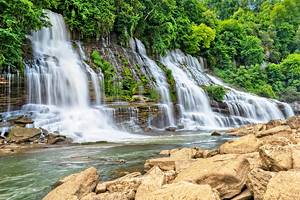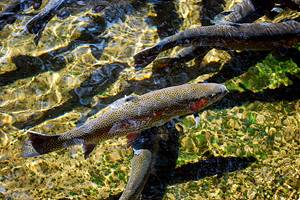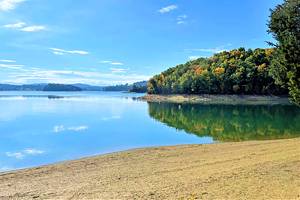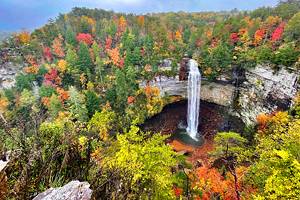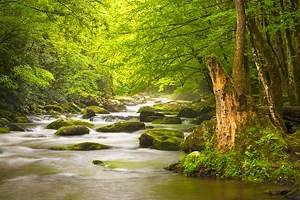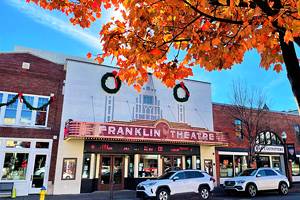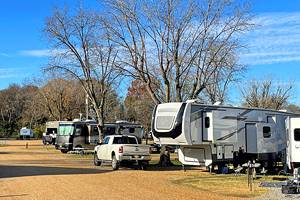National Parks in Tennessee
Co-author Joni Sweet has traveled to Tennessee twice, including on a cross-country road trip and a visit to Nashville.
As the most visited national park in the United States, Great Smoky Mountains National Park is a standout among national parks in Tennessee. This national park and one other park on our list are both associated with outdoor recreation and splendid scenery. The rest of the parks have strong ties to Civil War history. They include historic sites and landmarks, military parks, historical parks, battlefields, and scenic trails.
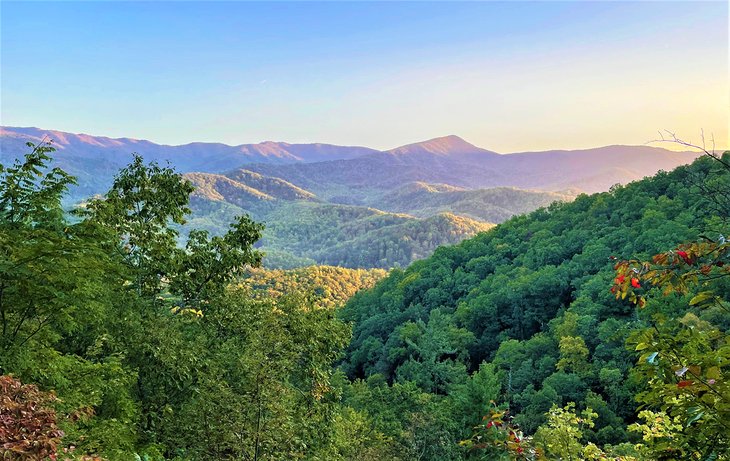
Nature and history know no boundaries, so three parks on our list are located in more than one state. For example, Cumberland Gap National Historical Park is located in Kentucky, Virginia, and Tennessee. Tennessee Civil War National Heritage Area covers the entire state and encompasses several sites on our list including Shiloh National Military Park, Andrew Johnson National Historic Site, Chickamauga and Chattanooga National Military Park, Stones River National Battlefield, and Fort Donelson National Battlefield.
National parks in Tennessee are easily accessible even when they are remote. Some of these parks, such as the Great Smoky Mountains, are popular, so plan ahead. Whether you're looking for a place to visit with the whole family or you're a solo traveler, plan your trip with our list of the best national parks in Tennessee.
- Great Smoky Mountains National Park
- Shiloh National Military Park
- Manhattan Project National Historical Park
- Big South Fork National River and Recreation Area
- Stones River National Battlefield
- Andrew Johnson National Historic Site
- Fort Donelson National Battlefield
- Chickamauga and Chattanooga National Military Park
- Appalachian National Scenic Trail
- Cumberland Gap National Historical Park
- Natchez Trace Parkway
- Natchez Trace National Scenic Trail
- Trail of Tears National Historic Trail
- Obed National Wild and Scenic River
- Best Time to Visit the National Parks in Tennessee
Great Smoky Mountains National Park
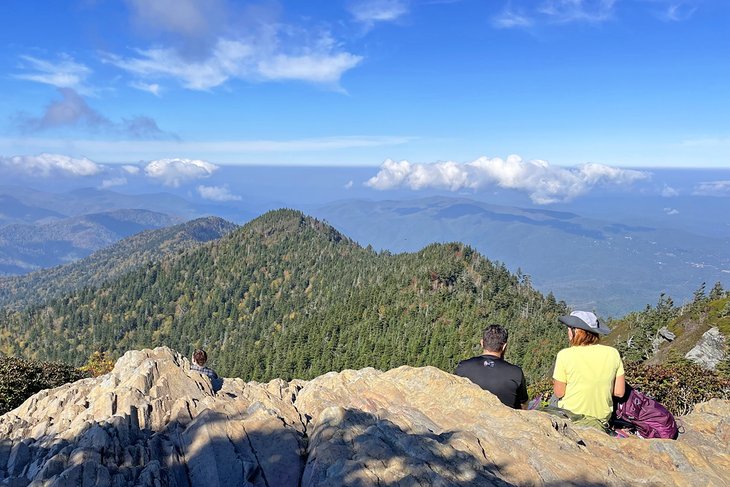
Highlights: Dense forests, rugged landscapes, and photogenic mountains
The top national park in Tennessee is the most popular destination in the National Park Service, receiving 12.5 million visitors annually. Great Smoky Mountains National Park is less than a day's drive from more than 60 percent of the U.S. population, but it wins the popularity contest for other reasons. Visitors from all over North America and the world flock to this densely forested and rugged landscape. They've admired photos of the park's mountaintops permeated by a hazy blue mist and want to see it for themselves.
The park features 522,427 acres of accessible wilderness and Clingmans Dome–the highest peak in the state at 6,500 feet. You can hike 900 miles on diverse trails (including several of the best hiking trails near Gatlinburg) and appreciate wildlife and 1,400 species of flowering plants. Head into the bush on a mountain bike or horse, camp in one of four campgrounds, and fish in a different river or stream every day of the week.
Most visitors see the Smokies during the heat of summer or when autumn leaves turn from green to gold and crimson. Enter the park from one of its primary gateways in Tennessee or North Carolina and enjoy scenic auto routes. You'll be dazzled by roiling rivers, pastoral havens, lush rainforests, and spectacular mountain passes.
Address: 107 Park Headquarters Road, Gatlinburg, Tennessee
Shiloh National Military Park
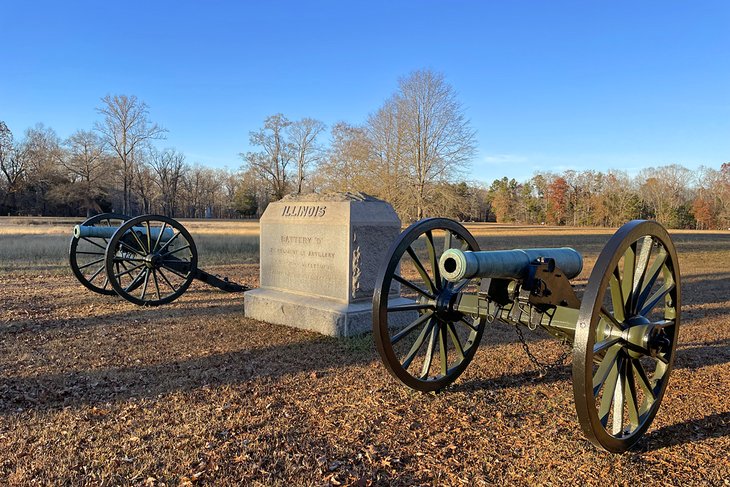
Highlight: Historical attraction where an important Civil War battle took place
The silence at Shiloh National Military Park can be sobering to visitors who know about the Battle of Shiloh in 1862. With 100,700 Union and Confederate soldiers engaged in battle–23,746 soldiers perished during two days of attacks and counterattacks. Today, the shadow of that memory hangs over the placid 9,324-acre park along the shores of the Tennessee River.
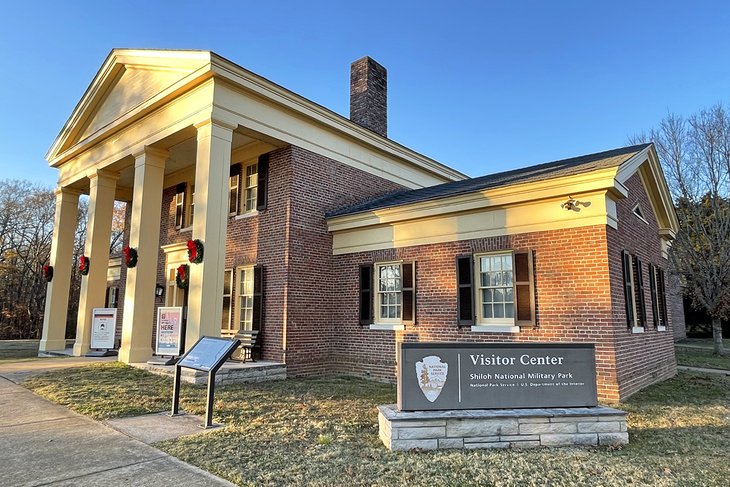
Get oriented at the visitor center by viewing a video about the battle. Pick up a copy of the tour map of the park to pinpoint locations of significant events and enhance your experience. Visit the Shiloh National Cemetery on the high bluff above the Tennessee River. Follow the park road south along the river to Shiloh Indian Mounds National History Landmark to see remnants of an Indigenous community dating back 800 years.
Address: 1055 Pittsburg Landing Road, Shiloh, Tennessee
Manhattan Project National Historical Park

Highlights: Historic facility that enriched uranium for use in the atomic bomb dropped on Hiroshima
Relatively unknown for its role in the Manhattan Project, Oak Ridge — 25 miles west of Knoxville — was one of three locations to bring the United States into the nuclear age by developing the first atomic bomb in 1945. In addition to Las Alamos, New Mexico, and Hanford, Washington, the Oak Ridge Reservation became the administrative and military headquarters for the highly secretive Manhattan Project. The town supported 75,000 people who built the complex for uranium and plutonium enrichment.
Start your tour of America's "Secret City" at the Children's Museum of Oak Ridge. A National Park Service ranger will provide you with information and a map for your self-guided tour of historic sites in town. The guided bus tour of these facilities leaves from the American Museum of Science and Energy.
Address: 461 W. Outer Drive, Oak Ridge, Tennessee
Big South Fork National River and Recreation Area
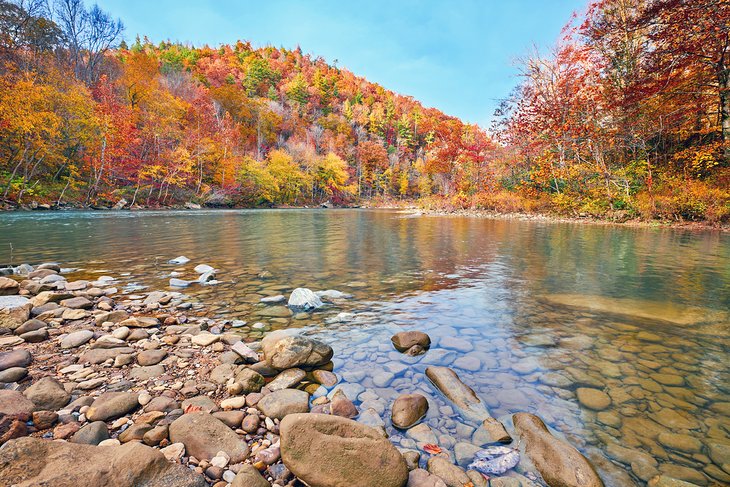
Highlights: A natural park with beautiful arches, sandstone bluffs, and few people
Big South Fork National River and Recreation Area is a wild and beautiful gem of 125,000 acres on the Cumberland Plateau that protects the Cumberland River. Despite its natural assets, it receives less than one-tenth the annual visitors of Great Smoky Mountains National Park. Among its features are 90 miles of sandstone bluffs and gorges, the river, and its tributaries.
Outdoor enthusiasts enjoy miles of hiking trails, horseback riding, rock climbing, and white water paddling. If you're seeking more adventure, discover arches and rock bridges tucked away in the forest. Most are not advertised, but this collection is the largest outside of Arches National Park in Utah.
If you wish to spend time in this recreation area, consider camping at Bandy Creek on the Tennessee side of the park. Lodging is at historic Rugby, 15 miles west of Oneida. The Cumberland River is not suitable for swimming; in season, Bandy Creek swimming pool is an inviting option. Big South Fork National River and Recreation Area is on the border of Tennessee and Kentucky, 61 miles northwest of Knoxville.
Address: 4564 Leatherwood Road, Oneida, Tennessee
Stones River National Battlefield

Highlights: Civil War battle site with historic cemeteries and remnants of a fortress
On the outskirts of Murfreesboro 34 miles southeast of Nashville, Stones River National Battlefield is an oasis of calm that betrays the tragic loss of life on December 31, 1862, and January 2, 1863.
In two days of fighting, 23,515 lives were lost — more than one-third of the 81,000 soldiers engaged in one of the bloodiest battles of the Civil War. Although the Northern Union Army suffered the largest number of casualties, the battle pushed the Southern Confederate Army into retreat and emboldened support for President Abraham Lincoln's Emancipation Proclamation on January 1, 1863.
Make your way to the visitor center for a map to direct your self-guided audio tour while driving, cycling, or hiking through the 570-acre park of meadows and stands of cedar. Along the way, you will encounter interpretative signs and exhibits.
Included in this national site are cemeteries for Union and Confederate soldiers, and remnants of the 200-acre Fortress Rosecrans. It was the largest fortified armory built during the war to support the Union campaign in Tennessee.
Address: 3501 Old Nashville Highway, Murfreesboro, Tennessee
Andrew Johnson National Historic Site

Highlights: Preserved structures showcase the life of Andrew Johnson, including his final resting place
Andrew Johnson was America's 17th president. He is identified in the history books as the "accidental president," "courageous commoner," and "tailor president." He was appointed following the assassination of Abraham Lincoln and led the reconstruction era following the Civil War.
Visit the Andrew Johnson National Historic Site in historic Greeneville—one of the best small towns in Tennessee. The historic site will enhance your knowledge about President Johnson's extensive political life and legacy. Although unschooled, his achievements bridged municipal, state, and federal governments.
See where Andrew Johnson lived and worked before throwing himself into public life. Preserved buildings at the historic site include his tailor shop from the 1830s, an early homeplace across the street from the visitor center, and the homestead. Drive up the hill to the cemetery where he was laid to rest.
Address: 121 Monument Avenue, Greeneville, Tennessee
Fort Donelson National Battlefield
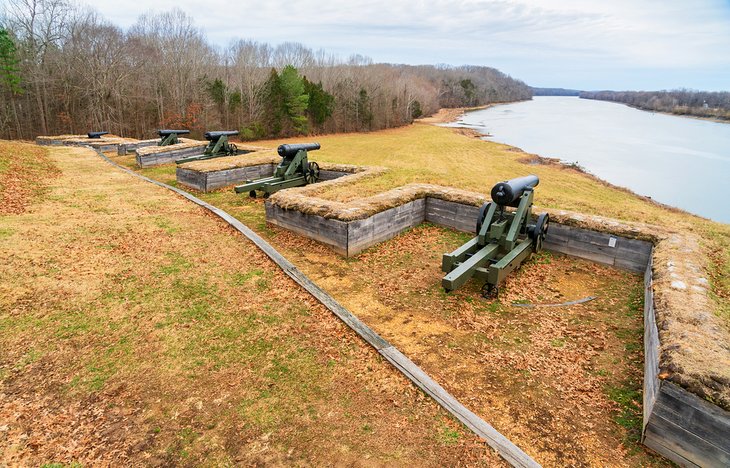
Highlights: Hiking trails, wildflowers, a historic cemetery, and a Civil War battle site
This Fort Donelson National Battlefield is significant as the location of the North's first great victory of the Civil War. In this 1862 battle, Union troops under General Ulysses Grant defeated the southern Confederate side. With the fall of Clarksville and Nashville to the Union Army, the Confederate States Army gave up much of central and western Tennessee plus southern Kentucky. Nashville became a major supply depot for the northern army.
A self-guided auto tour of the battlefield shows key features of the park. They include the Dover Hotel, also known as Surrender House, and the Fort Donelson Cemetery. From the hiking trails, watch for birds and wildflowers while admiring views of the Cumberland River and Barkley Lake. The battlefield straddles the border of Tennessee and Kentucky.
Address: 120 Lock D Road, Dover, Tennessee
Chickamauga and Chattanooga National Military Park

Highlights: Two large Civil War battlefield sites and pretty views
Chickamauga and Chattanooga National Military Park was the first federally protected battlefield in the United States. Decades following the end of the Civil War, soldiers from the Northern Union and Southern Confederate Armies collaborated to create a lasting tribute to military campaigns fought over Chattanooga.
There are two large battlefield sites to visit: Chattanooga and Chickamauga across the state line in Georgia. Second only to fatalities during the Battle of Gettysburg, the Chickamauga and Chattanooga death toll of 34,624 soldiers was the largest during the Civil War.
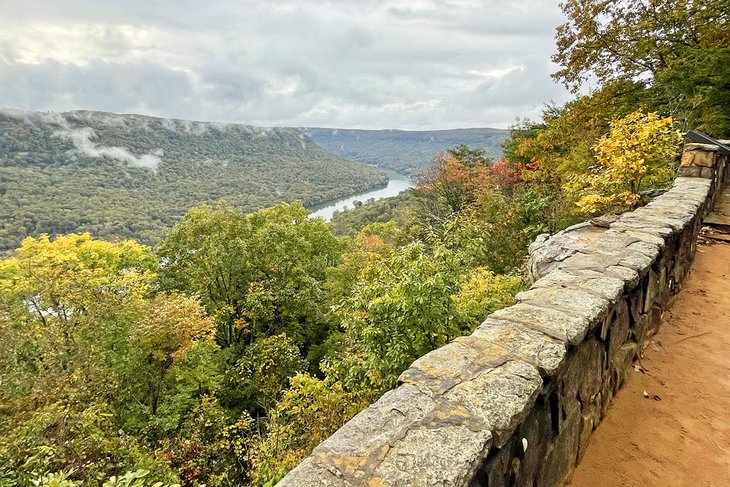
Appreciate stunning panoramic views of Chattanooga from Point Park on Lookout Mountain and the Tennessee River from Signal Point northwest of the city. A visit to the Chickamauga Battlefield starts with the park video at the visitor center and a self-guided auto tour.
Address: Point Park Road, Lookout Mountain, Tennessee and 3370 LaFayette Road, Ft. Oglthorpe, Georgia
Appalachian National Scenic Trail
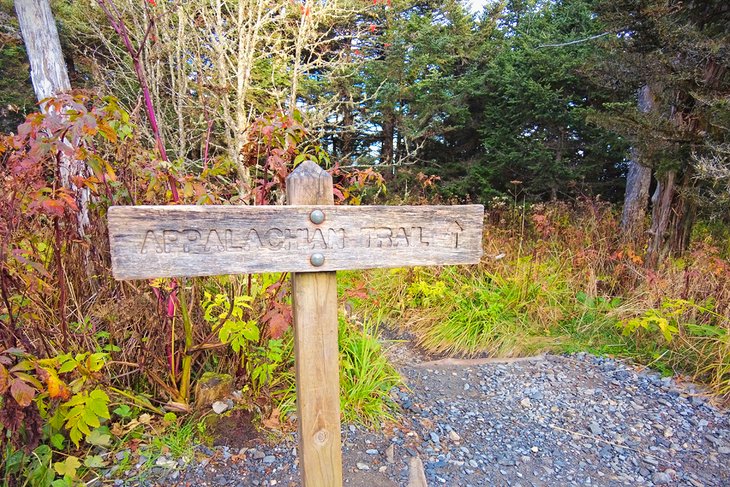
Highlights: The highest point in Tennessee, a legendary trail through 14 states
One of two scenic trails on our list, the Appalachian National Scenic Trail is a glorious footpath that covers more than 2,100 miles from Maine to Georgia. The Tennessee portion includes mountain ranges of the Cherokee National Forest and Roan Mountain, famous for rhododendrons. This part of the trail includes a swing by Clingmans Dome, the highest point in Great Smoky Mountains National Park. At 6,640 feet, the summit is also the highest in Tennessee.
Completed in 1937, "America's footpath" meanders through 14 states, including Tennessee. Multiple jurisdictions manage the trail including the National Park Service, Appalachian Trail Conservancy, US Forest Service, and an army of keen volunteers.
Cumberland Gap National Historical Park
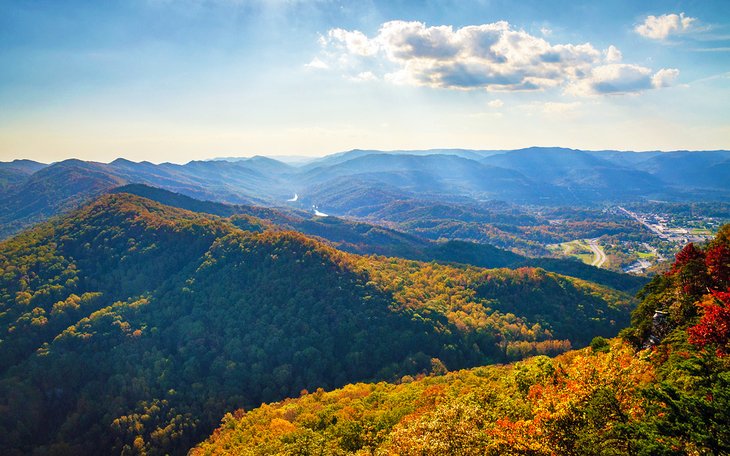
Highlights: Hiking trails, historic structures, and beautiful scenery
Indigenous people, pioneers, and buffalo went west via a pass in the mountains called Cumberland Gap. The journey from the Appalachian Mountains of Tennessee through the western gateway of Kentucky was initially blazed by Daniel Boone in 1775. In a word, traveling the gap was "challenging." Today's visitors are drawn to hiking trails, scenery, and historical buildings.
Tennessee claims a small piece of the 24,000-acre park with neighboring Kentucky and Virginia. Pinnacle Overlook and Gap Cove are in Virginia, while Ridge Trail and the Hensley settlement on Brush Mountain are in Kentucky. The Tennessee portion of the park is 65 miles north of Knoxville.
Address: 91 Bartlett Park Road, Middlesboro, Kentucky
Natchez Trace Parkway

Highlights: Bike, hike, or drive on a 444-mile road filled with adventure
Here's Natchez Trace Parkway by the numbers: 444 miles that can be driven, hiked, biked, and explored on horseback, tracing 10,000 years of history. Sample it by driving a few miles, admiring the scenery, camping in approved sites, and creating your own adventures in the great outdoors. Throughout the centuries, other travelers used this route for trading everything from goods to slaves. Indigenous people, settlers, and soldiers went this way before.
The parkway's northern terminus is Nashville and the southern end is Natchez, Mississippi. Along the way, you can hike, go camping, have a picnic, admire a waterfall, visit a national battlefield, go boating on a reservoir, visit missions, explore a Chickasaw village site, see an American Indian mound, visit ancient burial grounds, and cross a double-arch bridge. NTP covers three states —Tennessee, Alabama, and Mississippi — and a priceless amount of southeast history and culture.
Natchez Trace National Scenic Trail

Highlights: Self-guided hikes, camping, horseback riding, and diverse scenery
Natchez Trail National Scenic Trail is a hiking route that runs somewhat alongside Natchez Trace Parkway for 60 miles. Hike it or ride it on horseback. Do short self-guided nature trails. Discover a variety of terrain, some of which is muddy and swampy. Learn about local history while navigating natural settings. Camp in designated areas only–no reservations are required to camp or use the trail.
The national scenic trail is in Tennessee, Alabama, and Mississippi. It is divided into five sections with the 20-mile Highland Rim at the top end, just south of Nashville. This section is known as a hiking and equestrian corridor, with hiking and camping not permitted. Begin with a hike from the Garrison Creek Trailhead at milepost 427.6. You'll need to watch your footing on the steep sections. Enjoy views of the parkway, spring blooms, and fall colors at the Tennessee Valley Divide, milepost 423.9.
Address: Natchez Trace Parkway Visitor Center, 2680 Natchez Trace Parkway, Tupelo, Mississippi
Trail of Tears National Historic Trail
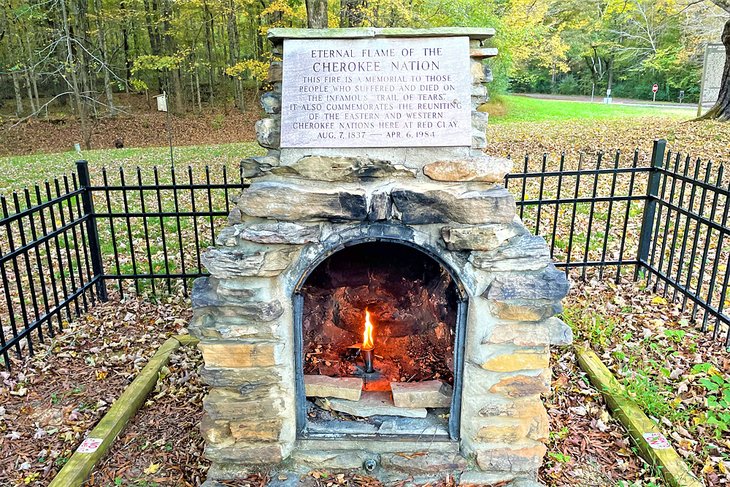
Highlights: A historic trail that commemorates the survival of Native Americans forced from their homelands
Covering 5,043 miles through nine states, the Trail of Tears National Historic Trail integrates land and water routes used by Cherokee families and communities during their forced relocation in 1837-1838. This migration concluded a complicated and tragic appropriation of Cherokee lands by the U.S. government. Thousands of Cherokee elders, men, women, and children were removed from ancestral territory east of the Mississippi and resettled in Oklahoma.
While you travel eastern and southern Tennessee, observe signposts related to the Cherokee Trail of Tears. To learn more, make your way to one of the most significant sites in Tennessee: Red Clay State Park, 26 miles east of Chattanooga. The start of the trail is where the Cherokee Nation convened its last general counsel before the U.S. Army enforced the Indian Removal Act in 1838.
Address: Red Clay State Park, 1140 Red Clay Park Road S.W., Cleveland, Tennessee
Obed National Wild and Scenic River
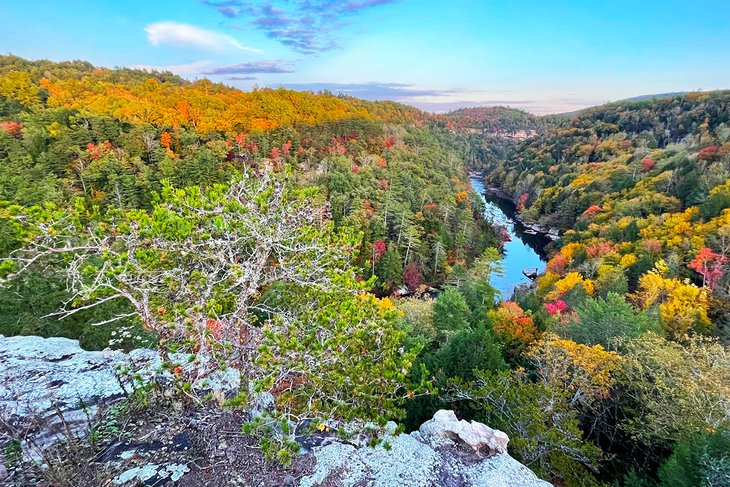
Highlights: Plunging canyons, spectacular views, and whitewater rafting
Drive one-hour northwest of Knoxville to a landscape that invites adventure in the mountains, along 500-foot-deep forested canyons, and down the Obed River and its tributaries. The Obed National Wild and Scenic River is an area imbued with natural and social history. It's accessible yet remote enough to feel the isolation of paradise discovered for the first time.
Off the beaten path from the visitor center at Wartburg, you will be enthralled by spectacular clifftop views and drop-offs. Experienced whitewater enthusiasts make their way here to paddle the area's diverse and challenging routes. Visitors seeking hiking, bouldering, rock climbing, and camping opportunities will be satisfied in this 520-square-mile section of the Cumberland Plateau.
Address: 208 Maiden Street, Wartburg, Tennessee
Best Time to Visit the National Parks in Tennessee
The best time to visit the national parks in Tennessee is in the summer, including June, July, and August. Expect long, sunny days, with temperatures climbing to the high 80s or low 90s Fahrenheit, depending on which park you're visiting. The weather typically drops into the high 60s or low 70s at night, so bring a jacket or a sweatshirt in case it's chilly and breezy.
As pleasant as the weather is in the summer, it can also be a bit muggy, so make sure you stay hydrated and wear light-colored clothing, and avoid intense hiking and other strenuous exercise in the hottest part of the day (typically mid-afternoon).
If you want to avoid traveling in the summer, the next best time to visit the national parks in Tennessee is in the shoulder seasons. This includes the late spring (April and May), as well as early fall (September and October). The weather will be cooler in the spring and fall shoulder seasons, but still warm and sunny enough to make the most of your time in the parks.





